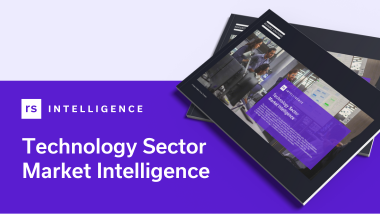How to attract talent by building a better skills radar
Employment, the nature of work and the skills required are changing faster than we’ve seen. Employees know this and are looking to employers to provide opportunities for them to upskill and retrain. Understanding this is important but knowing what you can do to attract and retain the best people with the right skills is becoming increasingly vital.
25% more people are likely to have to change their field of work than was predicted before the pandemic, with a different mix of occupations emerging. Signs of mass labor migration are already showing, with almost 4 million Americans quitting their jobs in April 2021 alone and half of managers, directors, and executives looking for a new job within 12 months. Being able to identify where the skills are for your organization is getting harder and a better skills radar is going to be essential.
Align employee and employer upskilling needs
The pandemic – both directly and indirectly – accounts for many of the reasons behind this but an often-ignored driver of this trend could lie with misaligned skillsets and a perceived lack of learning and development (L&D) opportunities at work. The recent Resource Solutions Skills Survey revealed that under half (49%) of professionals feel their employer has increased the number of upskilling opportunities for employees over the last 12 months, despite 97% being willing to upskill to stay relevant and employable in the future. If employers do not invest in their employees, the reverse is unlikely to hold true. While employee value proposition (EVP) and retention policies have a role in mitigating this, both direct and indirect benefits can be gained through building a better skills radar to meet the needs of the organization.
Identify the new skills required for new ways of working
Identify how your business models are changing and understand how these new approaches require new skills, which are increasingly difficult to source internally. Since traditional strategies are insufficient, the search for future skillsets involves looking in new places for new people with the help of new partners. This is shown by the gap between skills needed and skills available, meaning that of the 350 million jobs forecast by McKinsey to change over the next decade, some 75 million are expected to remain unfilled.
Create an agile organization able to engage a flexible contingent workforce
As a result of this and other organizational shifts, 60% of white-collar decision-makers expect temporary employment to significantly increase within their companies by 2030. Consider how you could engage with small core organizations on an as-needed basis. These temporary teams will likely become mainstream within a few years, driven by cost priorities, tech advancement, and the need to access talent. As both a strategic driver of business and a short-term fix, skills radars will become ever more valued.
Consider new ways of accessing skills
Like 80% of other leaders, determine how best to employ technology platforms to provide instant access to highly specialised, on-demand talent. Alumni programs, skills recycling programs (whereby skills redundant in one industry are needed in and redesigned for others), and new cross-sector partnerships that allow rapid transferring and repurposing of skills will appear. These are likely to augment emerging skills ecosystems, allowing for a broader range of non-traditional skills access. Most organizations are using digital talent platforms specifically to fill high-skills gaps quickly, while a significant number are aware of the potential of these platforms to transform their organization. However, as Harvard Business School notes, very few have developed a cohesive approach to incorporate highly-skilled freelancers into their business strategy.
Use technology to help build an agile, integrated workforce
Make it easier for teams to integrate temporary talent. Platforms, networks, partnerships, and ecosystems focusing on skills rather than jobs or sectors will be central to future efforts but will likely require enhanced use of technology to prosper. Consider how, predictive, and even prescriptive analytics, more cognitive forms of Artificial Intelligence (AI), and new forms of interaction via mixed reality, such as Virtual Reality and Augmented Reality, could help the organization to get the right person at the right time to the right area, regardless of geography.
Develop strong external partnerships
Identify the right strategic partners to help develop an agile and even predictive talent platform – or ecosystem – to source talent on an as-needed basis. The need to execute on metrics and technology, in addition to meeting internal requirements, can be beyond most L&D leaders alone. For example, less than 20% of organizations apply predictive analytics in addressing people issues effectively, despite the clear need from a corporate, candidate and employee experience perspective. The relationship between a given role and the skills needed versus those used are increasingly out of balance, resulting in talent being more likely to leave, lower morale, and suboptimal business outcomes.
Build a fluid organization with a diversity of skills
Consider how accessing skills, talent and ideas we need will demand that we create fluid organizational boundaries and develop a more finely tuned and wider searching skills radar. With ecosystems becoming the dominant organizational model and driver of value, the chance for third parties to assist in what were once core organizational areas is growing. These agile workforce strategies are forecast to become mainstream for 71% of organizations by 2023, which at scale will ensure significant cost savings. It could also boost diversity, which could be indirectly boosted by the pandemic. The advent of widespread homeworking could help tap potential talent pools unable to compete in dense office environments because of geography or even mental health concerns. Major organizations are already banking on neuro-diverse talent (those with the skills but not the proficiency to work in crowded offices, for example) to complement their talent needs.
Create new metrics
The shift into ecosystems and from jobs to skills will require you create new metrics able to value human capital. Currently, 55% of organizations do not provide training for their contingent workforce, highlighting a gap between workers and employer expectations and an underappreciation of the importance of workforce ecosystems. Better aligning EVP, technology, talent access, and data analytics could help better identify and access current and future skills needs. This also requires buy-in from upskilling providers, organizations, talent and acquisition professionals and the on-demand worker, with risk and cost-sharing potentially distributed over the broader ecosystem.
The workforce and the individual worker are undergoing a great deal of change, with more skills and roles being impacted across more sectors. Having an effective skills radar will be essential alongside strong partners and accurate information to base decisions on.
Find out more about what skills today’s candidates want to develop read our Skills Survey report.












